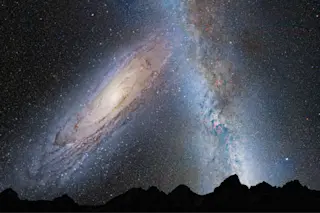This story was originally published in our March/April 2022 issue. Click here to subscribe to read more stories like this one.
Stars and galaxies move around us at a pace that seemsglacial on human time scales. Their dance is exceedingly gradual, taking place over billions of years. But if we could see time the same way the stars do, the neighborhood around our Milky Way Galaxy would appear surprisingly active.
Galaxies swing around one another, slowly spiraling together until they merge. Many don’t travel alone but bring companions with them, in a dark collision that may tear some stars from the heart of their homes and splay them across the sky. Other regions grow rich in gas and dust and begin, in their newfound opulence, to birth new stars. The dance of the galaxies is slow and violent, filled with both life and death.
The Milky Way drives the motion ...















